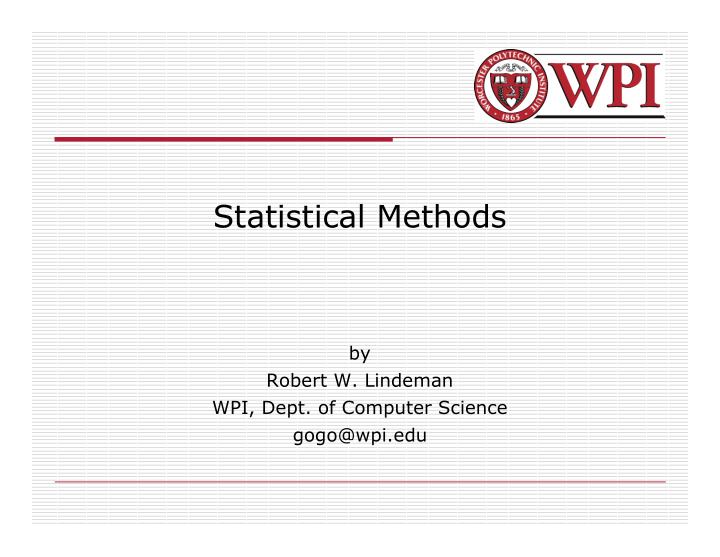



Statistical Methods by Robert W. Lindeman WPI, Dept. of Computer Science gogo@wpi.edu
Descriptive Methods Frequency distributions How many people were similar in the sense that according to the dependent variable, they ended up in the same bin Table histogram (vs. bar graph) Frequency polygon Pie chart R.W. Lindeman - WPI Dept. of Computer Science 2
Descriptive Methods (cont.) Distributional shape Normal distribution (bell curve) Skewed distribution Positively skewed (pointing high) Negatively skewed (pointing low) Multimodal (bimodal) Rectangular Kurtosis High peak/thin tails (leptokurtic) Low peak/thick tails (platykurtic) R.W. Lindeman - WPI Dept. of Computer Science 3
Descriptive Methods (cont.) Central tendency Mode Most frequent score Median Divides the scores into two, equally sized parts Mean Sum of the scores divided by the number of scores Normal distribution: mode ≈ median ≈ mean Positive skew: mode < median < mean Negative skew: mean < median < mode R.W. Lindeman - WPI Dept. of Computer Science 4
Descriptive Methods (cont.) Measures of variability Dispersion (level of sameness ) Homogeneous vs. heterogeneous Range max - min of all the scores Interquartile range max - min of the middle 50% of scores Box-and-whisker plot Standard deviation ( SD , s , σ , or sigma ) Good estimate of range: 4 * SD Variance ( s 2 or σ 2 ) R.W. Lindeman - WPI Dept. of Computer Science 5
Descriptive Methods (cont.) Standard scores How many SDs a score is from the mean z -score: mean = 0, each SD = +/-1 z -score of +2.0 means the score is 2 SDs above the mean T -score: mean = 50, each SD = +/-10 T -score of 70 means the score is 2 SDs above the mean R.W. Lindeman - WPI Dept. of Computer Science 6
Bivariate Correlation Discover whether a relationship exists Determine the strength of the relationship Types of relationship High-high, low-low High-low, low-high Little systematic tendency R.W. Lindeman - WPI Dept. of Computer Science 7
Bivariate Correlation (cont.) Scatter plot Correlation coefficient: r -1.00 0.00 +1.00 •Negatively correlated •Positively correlated •Inverse relationship •Direct relationship •High-low, low-high •High-high, low-low High Low High Strong Weak Strong R.W. Lindeman - WPI Dept. of Computer Science 8
Bivariate Correlation (cont.) Quantitative variables Measurable aspects that vary in terms of intensity Rank ; Ordinal scale : Each subject can be put into a single bin among a set of ordered bins Raw score : Actual value for a given subject. Could be a composite score from several measured variables Qualitative variables Which categorical group does one belong to? E.g., I prefer the Grand Canyon over Mount Rushmore Nominal : Unordered bins Dichotomy : Two groups (e.g., infielders vs. outfielders) R.W. Lindeman - WPI Dept. of Computer Science 9
Reliability and Validity Reliability To what extent can we say that the data are consistent? Validity A measuring instrument is valid to the extent that it measures what it purports to measure. R.W. Lindeman - WPI Dept. of Computer Science 10
Inferential Statistics Definition: To make statements beyond description Generalize A sample is extracted from a population Measurement is done on this sample Analysis is done An educated guess is made about how the results apply to the population as a whole R.W. Lindeman - WPI Dept. of Computer Science 11
Motivation Actual testing of the whole population is too costly (time/money) "Tangible population" Population extends into the future "Abstract population" Four questions What is/are the relevant populations? How will the sample be extracted? What characteristic of those sampled will serve as the measurement target? What will be the study's statistical focus? R.W. Lindeman - WPI Dept. of Computer Science 12
Statistical Focus What statistical tools should be used? Even if we want the "average," which measure of average should we use? R.W. Lindeman - WPI Dept. of Computer Science 13
Estimation Sampling error The amount a sample value differs from the population value This does not mean there was an error in the method of sampling, but is rather part of the natural behavior of samples They seldom turn out to exactly mirror the population Sampling distribution The distribution of results of several samplings of the population Standard error SD of the sampling distribution R.W. Lindeman - WPI Dept. of Computer Science 14
Analyses of Variance (ANOVAs) Determine whether the means of two (or more) samples are different If we've been careful , we can say that the treatment is the source of the differences Need to make sure we have controlled everything else! Treatment order Sample creation Normal distribution of the sample Equal variance of the groups R.W. Lindeman - WPI Dept. of Computer Science 15
Types of ANOVAs Simple (one-way) ANOVA One independent variable One dependent variable Between-subjects design Two-way ANOVA Two independent variables, and/or Two dependent variables Between-subjects design R.W. Lindeman - WPI Dept. of Computer Science 16
Types of ANOVAs (cont.) One-way repeated-measures ANOVA One independent variable One dependent variable Within-subjects design Two-way repeated-measures ANOVA Two independent variables, and/or Two dependent variables Within-subjects design R.W. Lindeman - WPI Dept. of Computer Science 17
Types of ANOVAs (cont.) Main effects vs. interaction effect Main effects present in conjunction with other effects Post-hoc tests Tukey's HSD test Equal sample sizes Scheffé test Unequal sample sizes R.W. Lindeman - WPI Dept. of Computer Science 18
Types of ANOVAs (cont.) Mixed ANOVA 2 x 3 Time of day Real Walking / Walking in-place / Joystick R.W. Lindeman - WPI Dept. of Computer Science 19
References Schuyler W. Huck Reading Statistics and Research , Fourth Edition, Pearson Education Inc., 2004. R.W. Lindeman - WPI Dept. of Computer Science 20
Recommend
More recommend